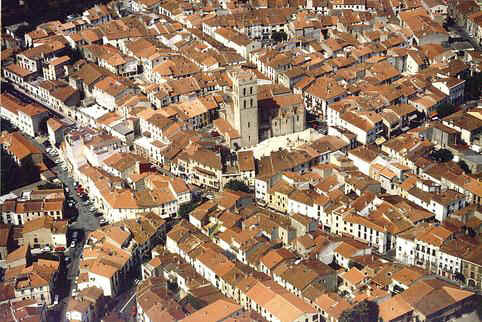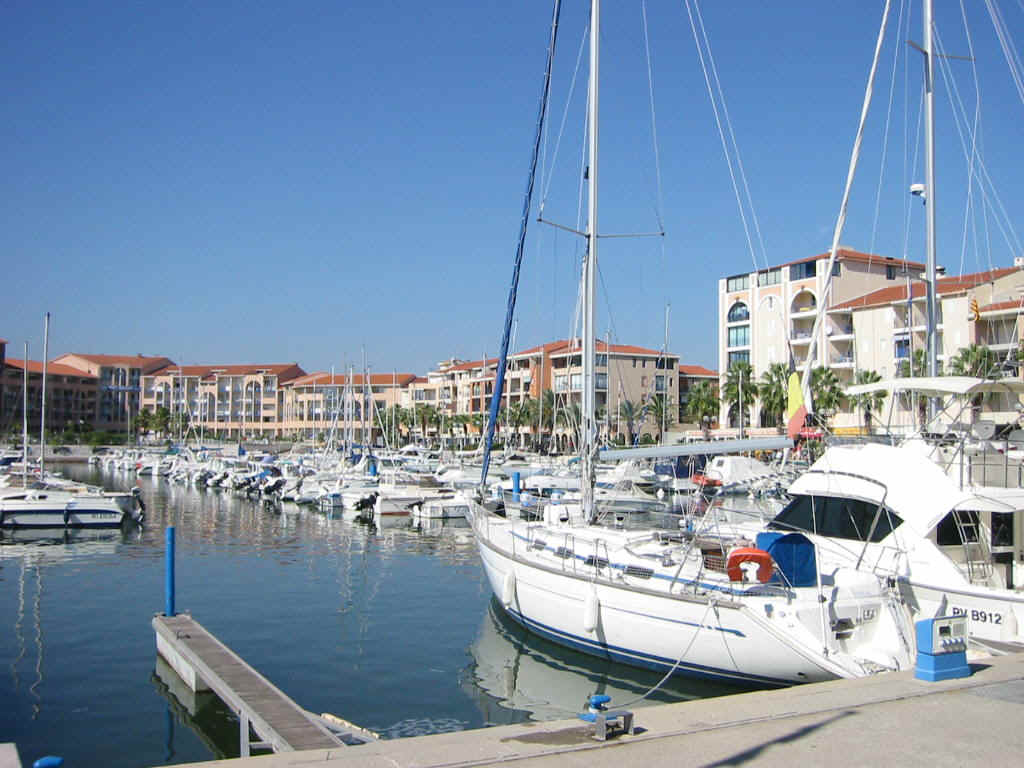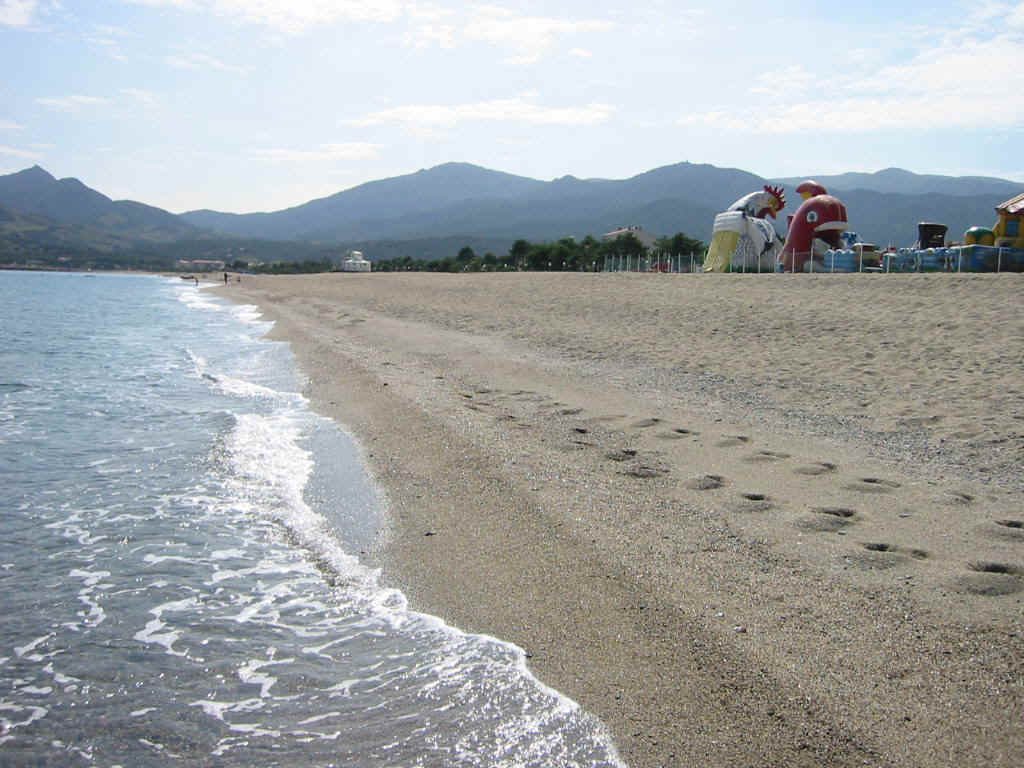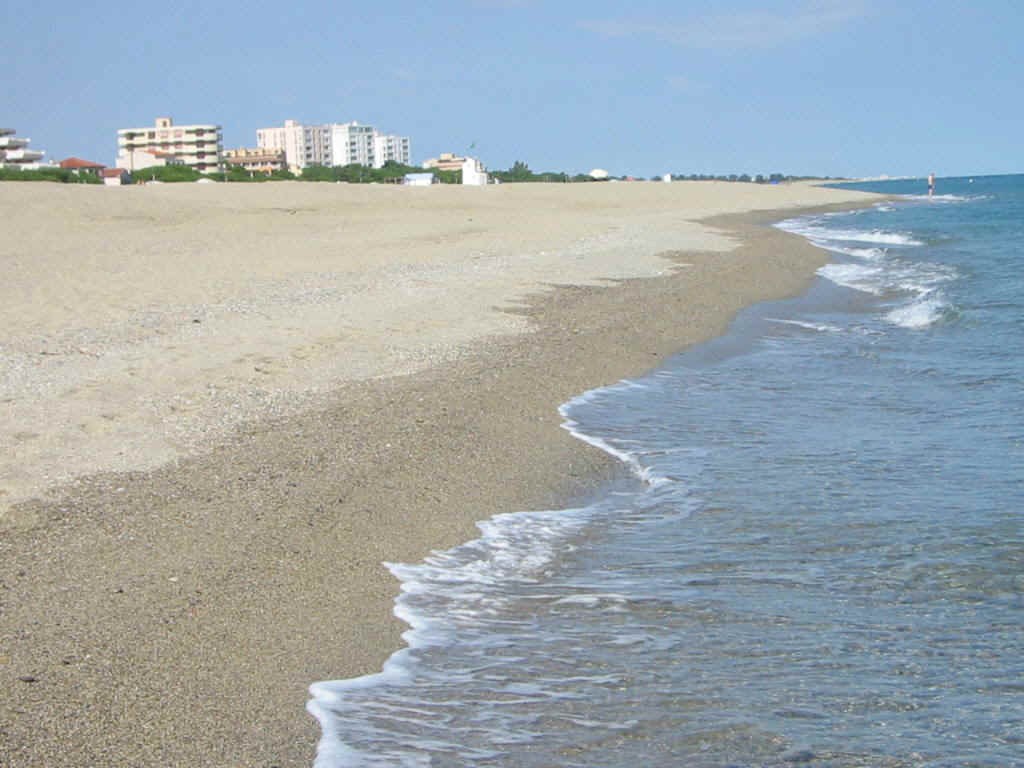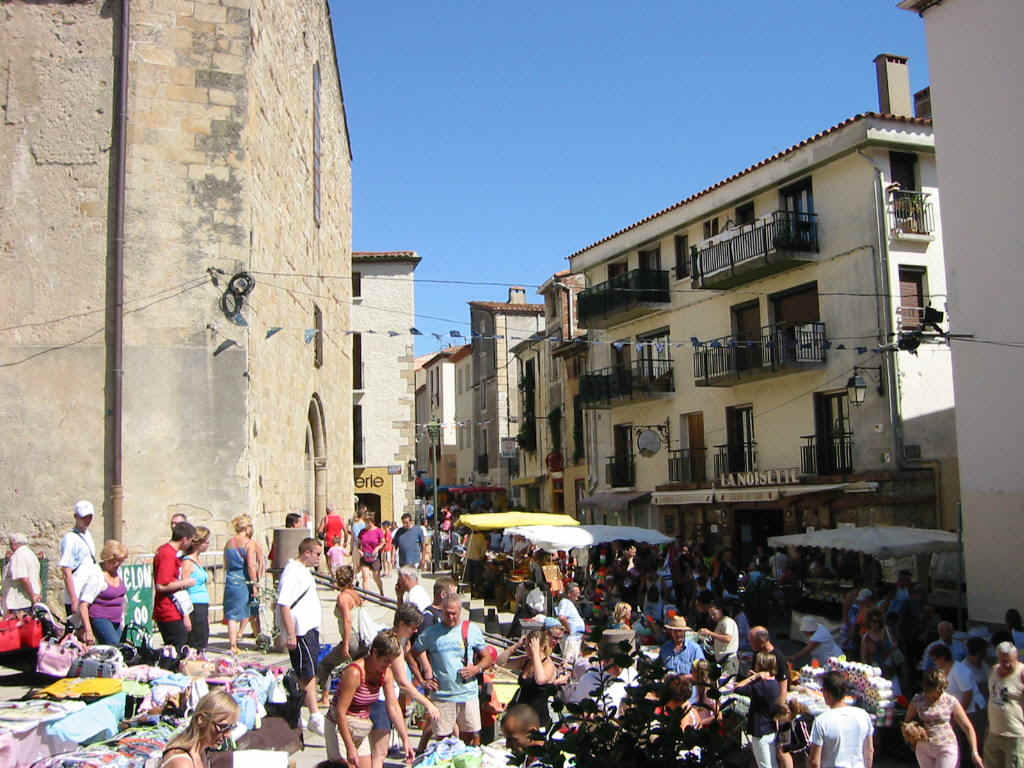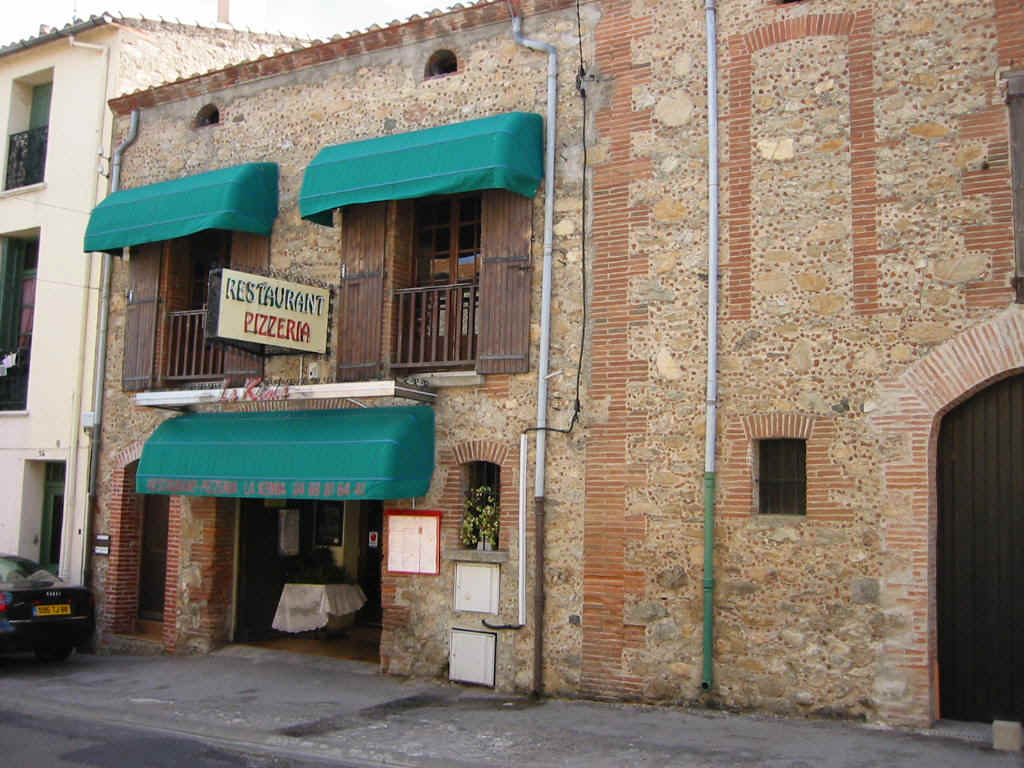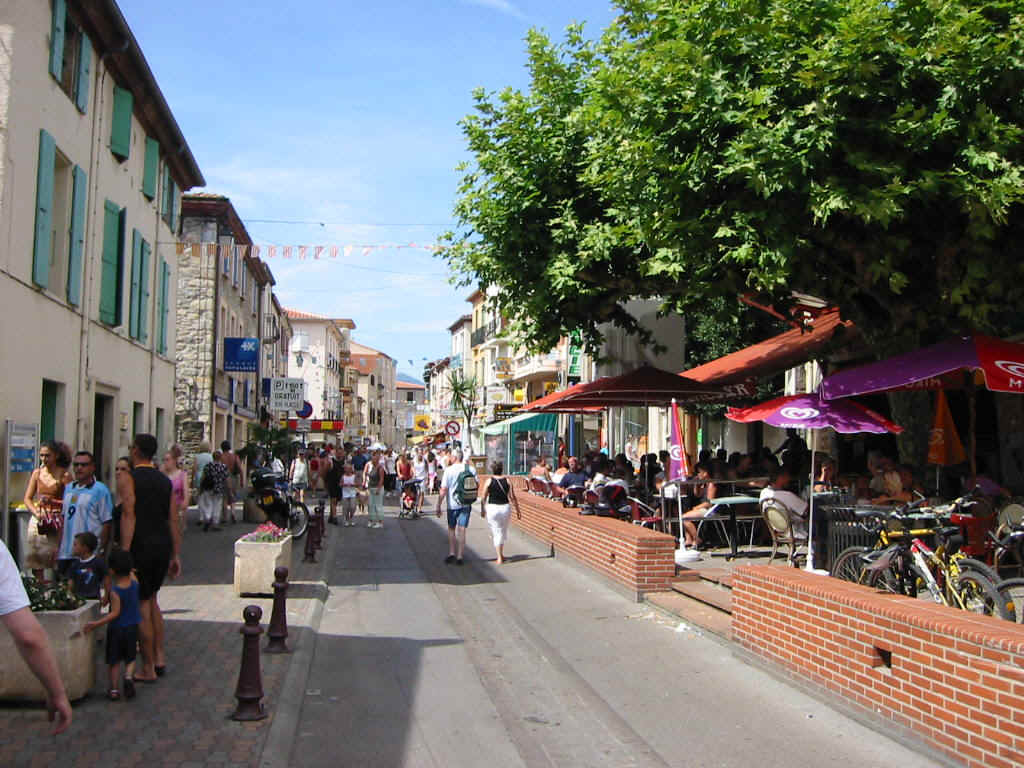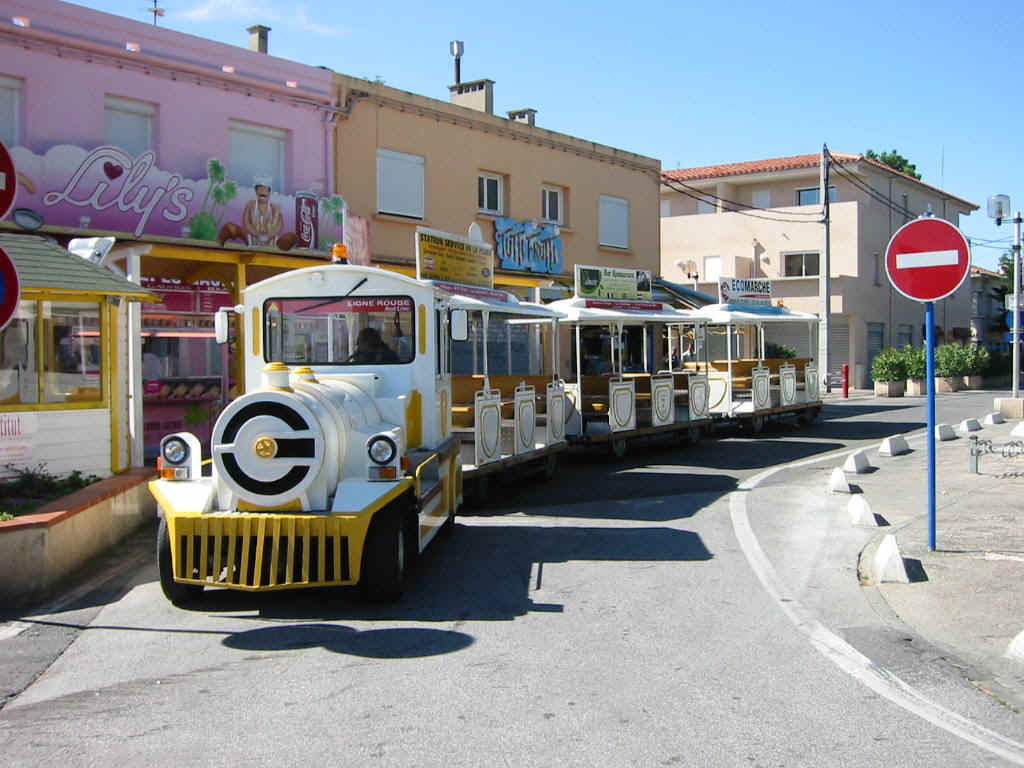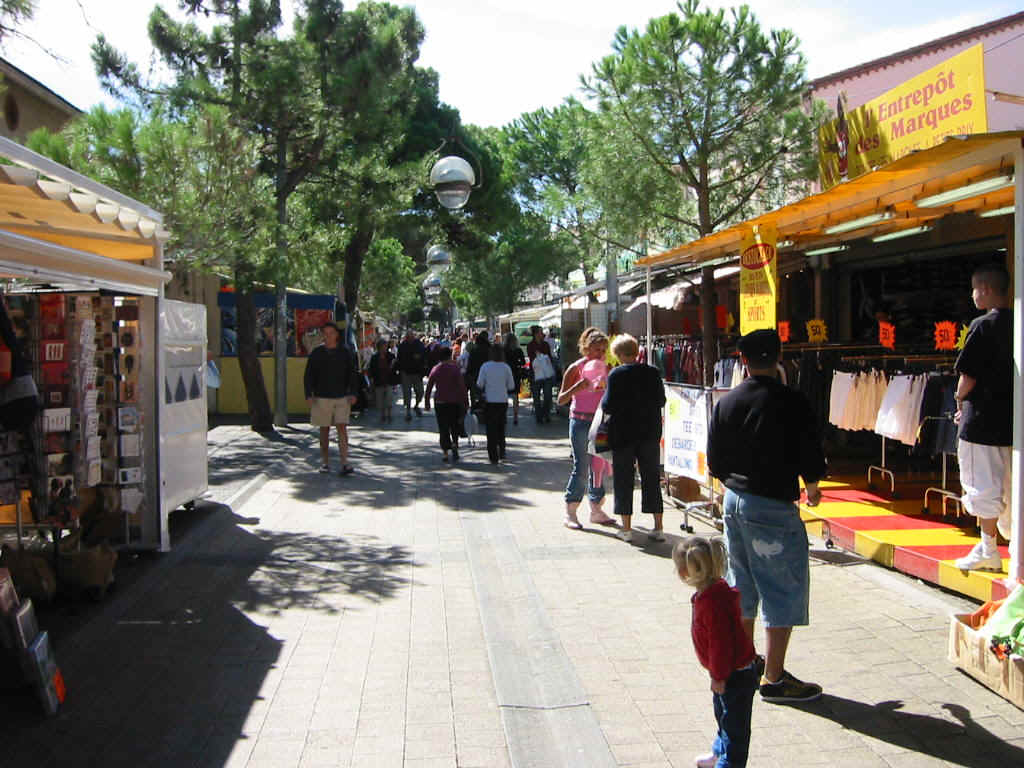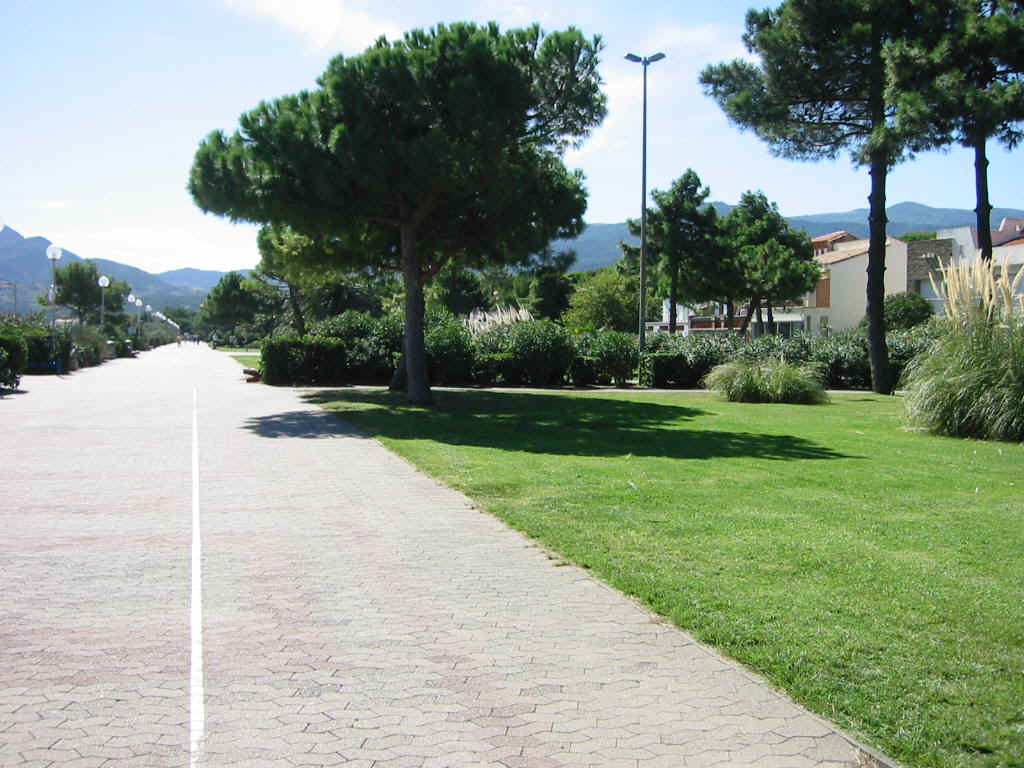History of Argeles
Translation and adaptation made from various sources
from French into English
ARGELES-SUR-MER
There are two possible
explanations for the name of Argelès:
Place planted with broom ("argelac"
or "argelaga" in Catalan).
This etymology, appearing on the town shield, accepts neither linguistic analysis nor
comparison with the numerous towns having identical or similar names.
Clayey place (from the latin word "argila", clay).
Obviously, it's the right explanation. The first mention dates from 879: "Villa
de Argilariis", then the name is used again with the forms "Argelarium,
Argelaria, Argilaria" in the 10th century.
On Argelès-sur-Mer coat of arms, the mention "qui s'hi
acosta, té resposta" can be seen. Which means "gather thistles, expect
prickles" or "who rubs there, pricks himself there". |
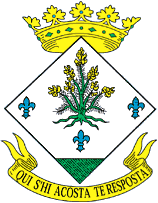
|
The name of Argelès is a derivative of the word "Clay". It means "Fatty
Ground exactly", to take within the meaning of "Fertile Ground".
Prehistory with Argelès on sea arises during the Neolithic era, more precisely the
megalithic time. Two dolmens are on the territory of the commune: the "Collet of
Collioure" and the dolmen say "Cova del Alarb". They have every both summer
classified historic buildings on November 3, 1958.
THE HISTORY OF ARGELES SUR MER
First mentions of the village
One finds the first mention of Argelès into 981 on a document indicating that the city
belongs to the abbey of Génis Saint of the fountains and that it was in addition about
the extreme limit of the possessions of this abbey (and due, further it is the sea...)
This document mentions already the presence of a fortified town belonging as all the
remainder of Roussillon to the descendant of the count Guifred the Hairy one.
Until 1258, date of the treaty of Corbeil fixing a border enters France and the kingdom
of Aragon, it does not have there traces of Argelès. Although the border, placed much
more at North (in Bélesta) did not have effect on the everyday life, the fact of changing
capacity officially directing structured the life of the villages.
Thus during the XIII E century a house of the Order of the Temple appeared,
whose tutor was certain Borrellus in 1273. These houses were very frequent in the cities,
some had so much importance which they directed the city itself.
Catch of the city by Pierre IV of Aragon
In 1276 king d' Aragon Jacques the Conqueror dies by separating his kingdom into two:
the elder one takes its succession while the junior receives the kingdom of Majorque. From
the very start of separation they are opposed, the elder one not recognizing the
separation of the grounds. But they were well obliged to cohabit time to find an
agreement, agreement signed in 1279. 19 years later, in 1298, than this treaty was renewed
in Argelès.
Until 1344, military year of reconquest of the kingdom of Majorque by Aragon, the two
monarchs fought regular battles. However Argelès are at the border. It is thus quite
naturally that the population lived its years fastes for Perpignan in fear.
In 1343, Pierre IV of Aragon attacks the kingdom of Majorque. Its troops cross the
Pyrenees, take Banyuls, Collioure in turn and make the seat in front of first of all the
Tower of Pujols , a tower mentioned as of 1145 which belonged first of all to Bérenger de
Llupia (count de Taxo), then in Gerard of Roussillon (in 1166) which bequeathed it with
its immense grounds to king de Majorque.
This tower sees arriving the army of Pierre IV of Aragon on June 2, 1343. The attack is
given, but Pujols is defended well. Pushed back, the attackers withdraw themselves. The
following day they attack the town of Argelès, but there still the inhabitants, helped by
a troop of mercenaries génois manage to push back them.
A seat is established around the walls of the city. It succeeded in making open the
doors later three days. June 6, 1343, the city is conquered by Pierre IV of Aragon.
French occupation
May 9, 1462 king d' Aragon Jean II, owner of Roussillon signs a treaty of alliance with
the king of France Louis XI with an aim of subduing the perpetual revolt of the Catalans
of Barcelona. The army of king de France loses the battle on 3 October 1462 and invaded
Roussillon as reprisals against king d' Aragon.
Decoration of Capbreu d' Argelès, XIII E century
Argelès is again occupied by foreign troops. We do not have many documents reporting
this episode but it seems that the city fell without resistance.
The seizure of France will be illegal until 1472. On this date king d' Aragon proposes
in France to restore Roussillon to him in an official way against a political support ,
which it accepts. Argelès will thus remain French.
One do not know anything the policy applied locally, but that of Perpignan is used to
us as example. Extremely of his first experiment, the king of France makes reign terror on
his new grounds, obliging the majority of the opponents to flee towards Barcelona.
This established fact will last until January 19, 1493, date of the signature of the
treaty of Barcelona. By this treaty Charles VIII king de France returns Roussillon to king
d' Aragon.
Treaty of the Pyrenees and war of 1793
From 1618 to 1648 the fight between France and Spain starts again. The French forces
penetrate in Roussillon, conquer the territory.
Argelès is taken in 1641 by the French General Meilleraye, who establishes a small
garrison there. January 7 1642 Spanish takes it again after three days of combat. It will
be again taken again in 1646. May 9, 1659 a cease-fire is issued, it will bring to the
signature of the treaty of the Pyrenees fixing a new border.
One could believe that the border was final, but the hostilities began again in 1793 on
the initiative of Spain. This year there a strong army crosses Albères by the collar of
Perthus and took several cities. Argelès, always placed at the border into sudden the
consequences. It was taken on May 23, 1793 and Spanish made of it the store of an army of
4000 men on standby between the beach and the city (with their 500 horses).
This war lasted 2 years, the line of much moving face. This part of Albères was
however not released by French before 1795.
Modern time
The seaside resort goes back to 1860, at the time of the plantation of the first pine
forests. Thereafter, the municipality made all the efforts necessary to develop the modern
town of way, creating in turn the infrastructures and the activities related to tourism.
The first camp-site, the camp-site Bouix (which always exists), was created in 1953 close
to the beach. At that time there was nothing at this place, if they are not wild campers.
The Church Our Lady Del Prat
The parish church of Argelès on sea was built during the XIV E century on
the basis of initial Romance church, listed in 1178.
Its bell-tower, classified Historic building, was set up in 1341. The gate dates from
the same time, it has interesting capitals. Internally, the oldest element are the
baptismal funds, which have an inscription of XIIIe century. The remainder is more recent.
The retables were manufactured between the XV E century (St Michel), the XVII E
(high altar, of Passion, St Joseph - fact in 1700, St Jean - fact in 1620) and the
XVIII E (St Jacques). It also shelters a wheel with small bells, a wrought iron
candlestick of the XVI E century, a dish with search of 1673 and statues of St
Côme and St Damien of the XVII E century.
Hermitage Our Lady of Life
On the territory of Argelès on sea an old vault, Our Lady of Life is This church was
perhaps the seat of an old parish, but we have not enough information to have the
certainty of it. Other sources, more serious, accredit the presence of a priory who would
be the true origin of the place. In fact both are possible, the priories being rather
appeared towards the XIII E century.
The first mention of Our Lady appears in 1293 under the name of loco vocato Madgalenes.
Indeed, the church Our Lady of Life has a recent name, it was known initially under that
of Marie-Magdeleine church. In 1312, it reappears ( ecclesia Sanctae Mariae Magdalenae ),
then disappears from the texts to the XVII E century.
We cannot be sure of its destiny during its years but by analogy with others parishes
its history becomes limpid. The presence of Argelès, in edge of sea and equipped with
fortifications with fact of concentrating the populations of the surrounding valleys in
the city, which has little with little désertifier neighbourhoods. The church Marie
Magdeleine stopped her religious activity following a deficiency into faithful in the
area.
This forgotten church will make however the beautiful days of the population to the
XVII E century. It should be said that the end of the XVII E century
marked a deep change in practice of the eremitism. Withdrawn hermits, seeking deepest
spirituality by a poor material life, they had become monks in relation to the local life.
The hermitages multiplied, recovering and modifying in-depth the old churches or vaults
castrales, not inevitably far away from the villages.
The hermits were thus accessible. They were seen like people holding the knowledge,
they had the capacity to judge a situation and to give councils. They are reflected to
move, with to go in contact with the villagers with an aim of searching for their
hermitages. Indeed, they had one role of reception of the travellers, and for this reason
they were to ensure the receipts of what one would call today a list stage. These
populations, in spite of this usual search, favoured rather what will become an
institution. Catalan hospitality was also built on top.
Reconverted into hermitage at one time when they become à.la.mode, the vault Ste Marie
Magdeleine will be transformed into 1666. She appears in 1688 among the list of the
hermitages of Roussillon (hermita of Santa Magdaléna), then she will change patron saint
in 1746, becoming the hermitage Our Lady of Life, name under which know we it today.
In 1790 the French revolution put at bottom certain pillars of the Church. In
particular, goods of the Church are declared goods of State, and as such put on sale. Only
will be able to escape from it them parish churches, which means that the hermitages of
the department, although always desired by the inhabitants, were sold to private
individuals or communes. The hermits disappeared, and it was the end of Our Lady of Life.
To also see near this hermitage, the interesting vault préromane, dating from X E
century is dedicated to St Jerome.
In the early 20th century, Argelès-sur-Mer was a large,
rural village living mainly on agriculture, breeding and craft industry. World War I
decimated a generation: 122 young inhabitants of Argelès died in that
war.
During the first half of the 20th century the town was beginning to be equipped with
public services. Electricity appeared little by little (1910-1938) as well as running
water. A rubbish collection service started (1923), the co-operative wine-cellar
saw the light of day (1925), there were the first tourists on the beach playing
tennis on the courts in the pine forest, going to the huts built on the sand or
relaxing in bars and restaurants.
February 1939 was a turning point in the history of Argelès. As they were
fleeing the Civil War and Franco's military regime, 500,000 refugees crossed the
frontier. A camp was urgently set up on the beach. Nearly 200,000
persons stayed in the camp. From time to time, there were nearly 80,000 persons
surviving in awful conditions. The camp was closed in
1941.
After World War II, from where 22 children of the village never returned, and the
necessary period of reconstruction (30% of the villas of the beach were destroyed by the
German army), in the latter half of the century, the town developed thanks to
tourism industry. Public services and infrastructures multiplied: waste water treatment
plant (1957), schools, roads, public facilities, Gaston Pams stadium and refuse
incineration plant (1971), swimming-pool (1972), cinema (1985), development area (1985),
creation of Port Argelès (1989), development of the diversion road
(1993), refuse disposal site (1993), social housing (1991 and 1998),
multipurpose room (1999), restoration of the heart of the village
(2002)...
In 2002, the creation of the Community of Municipalities of the Albères gathering
the eight villages and towns of the district confirmed the place of Argelès as the
central town of a living area of 25,000 inhabitants.
Over a century, Argelès has converted from a village into a small town combining
tradition and modernity
Seafront promenade
Among all the coastal towns of the Pyrénées-Orientales, Argelès-sur-Mer is the town
that boasts the longest coastline: 10 kilometres of coasts among which 7 of sandy
coast and 3 of rocky coves.
The jewel of the seaside is unquestionably the promenade which is parallel to the beach.
Built in the 1980s, 1.6km long, planted with lawns and Mediterranean vegetation, it
stretches from Port-Argelès to the pine forest giving shelter to several
thousands of trees. There were three parts in the building works: 1973, 1990 and
1994.
On foot, by bike, by rollers, walking or running, the seafront is, winter and summer
alike, the favourite place for pleasant walks by the sea.
THE HISTORY OF ARGELES SUR MER
The history of Argelès-sur-Mer, the first seaside resort
in the Pyrénées-Orientales and the second one in Languedoc-Roussillon, combines
with the development of tourism and leisure industry.
The major events of this history are the following ones:
1860: planting of the pine forest.
1893: creation of the first town housing estate south of the pine
forest (nowadays, allées Jules Aroles, des Tamarins and du Racou).
1904: creation of the local initiative committee prefiguring the future local tourist
office (1929).
1924: setting up of wood huts on the beach of the pine forest.
1930: urbanizing 75ha north of the pine forest and construction of the
Hotel Xatard (nowadays, Hotel Plage des pins).
1950: creation of the pilot camp, nowadays Roussillonnais campsite.
1954: creation of the first private campsite: Bouix campsite.
1962: classing the town as a holiday and seaside resort.
1964: inaugurating the new casino.
1965: creation of the Leisure Centre for the Young at the Roussillonnais
campsite.
1970: construction of the Coastal road between Argelès and Saint-Cyprien.
1971: creation of Municipal Tourist Office.
1973: first section of the construction of the seafront promenade.
1982: pedestrianizing allée Jules Aroles.
1989: inaugurating Port-Argelès.
1993: new premises of Municipal Tourist Office.
2001-2002: modernizing avenue Charles de Gaulle.
2002: modernizing the waste water treatment plant (capacity 120,000 inhabitants)
AN AERIAL VIEW OF ARGELES VILLAGE
DEEP IN THE SOUTH OF FRANCE
Deep in the south of France, next to the Mediterranean and in the foothills of the
Pyrenees, experience the warm, colourful atmosphere of Catalan life in Argelès-sur-Mer.
The jewel in the crown of the Côte Vermeille, 3 km from Collioure, Argelès-sur-Mer has a
7 km sandy beach and 3 km of coves lapped by some of the clearest water in the
Mediterranean.
An old Catalan town, Argelès-sur-Mer has seen many centuries of history, recorded in its
remarkable Museum, La Casa de los Alberès, in the heart of the old town next to the
medieval church.
Besides visiting the village and its museum, church, tower and ramparts, there are several
sights in the surrounding area that are worthy of a detour: - Taxo d’Avall, 11th C. castle and chapel - Tour Pujol, built in the early 12th C. - Site
d’Ultrera and the remains of the fortress - Notre-Dame-de-Vie - Saint-Laurent du
Mont, Romanesque church - Tour de la Massane, old signalling tower The surrounding area -
Collioure and the Château Royal (former castle of the Knights Templar) - Tour de la
Madeloc (old signalling tower) - Le Perthus and Bellegard Fort, built by Vauban -
Perpignan and the Palace of the Kings of Majorca, St-Jean Cathedral - Le Castillet, former
city gate - Salses and its 15th C. fortress - Villefranche de Conflent, a remarkable
walled town - Château Fort Liberia built by Vauban above Villefranche de Conflent - Castelnou,
a picturesque medieval village near Thuir - Prats de Mollo, a walled town with ramparts
reinforced by Vauban - The Cathar Châteaux - Saint Genis des Fontaines, its church and
cloisters - Saint André de Sorède, and its 12th C. Romanesque church - Elne, its
cathedral, cloisters and archaeological museum - Arles sur Tech, Ste Marie abbey, 13th C.
Gothic cloisters and the famous 4th C. sarcophagus known as Sainte Tombe, which
miraculously fills up with pure water every day - Serrabonne, Romanesque priory from the
11th and 12th C. - Saint Michel de Cuxa, Romanesque abbey from the 10th and 11th C., crypt
and tower from the 11th C., cloisters from the 12th C. - Saint Martin du Canigou, on a
splendid side, 11th and 12th C. abbey, accessible only on foot or in a jeep from Casteil
or Vernet Natural sites - Canalettes, Grandes Canalettes and Fontrabiouse caves - La Fou
and Galamus gorges - Ille sur Têt "Orgues" (geological rock formations) - Le
Canigou mountain - Saint–Thomas spa waters Sport: Boat trips and sea fishing, scuba
diving, boat hire, sailing, swimming, sea kayaking, tennis, horseback riding, archery,
cycling and mountain biking, go-karting, hiking, mini-golf, microlight flights, canyoning,
paragliding etc. Activities: fireworks, folklore, "Sardane" (Catalan dancing),
Château Valmy and its grounds, the Argelès eagles, amusement park, Luna Park, zoos.
Casino, cinemas, discos, bars, restaurants etc.

